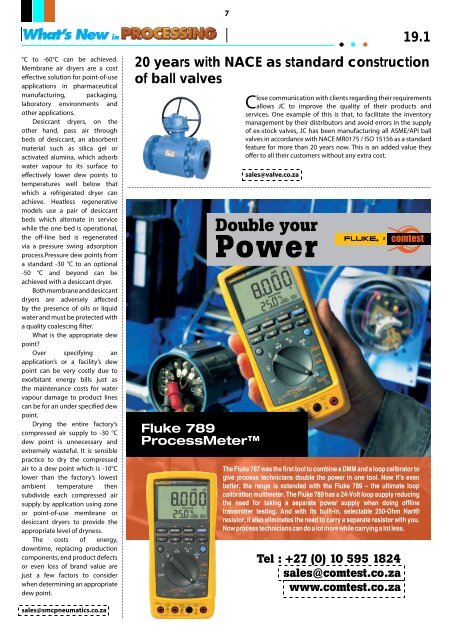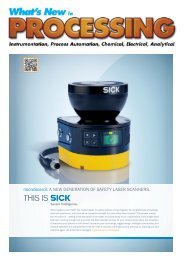WNIP Jan Feb 19.1 Digital low res
Create successful ePaper yourself
Turn your PDF publications into a flip-book with our unique Google optimized e-Paper software.
7<br />
<strong>19.1</strong><br />
°C to -60°C can be achieved.<br />
Membrane air dryers are a cost<br />
effective solution for point-of-use<br />
applications in pharmaceutical<br />
manufacturing, packaging,<br />
laboratory environments and<br />
other applications.<br />
Desiccant dryers, on the<br />
other hand, pass air through<br />
beds of desiccant, an absorbent<br />
material such as silica gel or<br />
activated alumina, which adsorb<br />
water vapour to its surface to<br />
effectively <strong>low</strong>er dew points to<br />
temperatu<strong>res</strong> well be<strong>low</strong> that<br />
which a refrigerated dryer can<br />
achieve. Heatless regenerative<br />
models use a pair of desiccant<br />
beds which alternate in service<br />
while the one bed is operational,<br />
the off-line bed is regenerated<br />
via a p<strong>res</strong>sure swing adsorption<br />
process.P<strong>res</strong>sure dew points from<br />
a standard -30 °C to an optional<br />
-50 °C and beyond can be<br />
achieved with a desiccant dryer.<br />
Both membrane and desiccant<br />
dryers are adversely affected<br />
by the p<strong>res</strong>ence of oils or liquid<br />
water and must be protected with<br />
a quality coalescing filter.<br />
What is the appropriate dew<br />
point?<br />
Over specifying an<br />
application’s or a facility’s dew<br />
point can be very costly due to<br />
exorbitant energy bills just as<br />
the maintenance costs for water<br />
vapour damage to product lines<br />
can be for an under specified dew<br />
point.<br />
Drying the entire factory’s<br />
comp<strong>res</strong>sed air supply to -30 °C<br />
dew point is unnecessary and<br />
extremely wasteful. It is sensible<br />
practice to dry the comp<strong>res</strong>sed<br />
air to a dew point which is -10°C<br />
<strong>low</strong>er than the factory’s <strong>low</strong>est<br />
ambient temperature then<br />
subdivide each comp<strong>res</strong>sed air<br />
supply by application using zone<br />
or point-of-use membrane or<br />
desiccant dryers to provide the<br />
appropriate level of dryness.<br />
The costs of energy,<br />
downtime, replacing production<br />
components, end product defects<br />
or even loss of brand value are<br />
just a few factors to consider<br />
when determining an appropriate<br />
dew point.<br />
20 years with NACE as standard construction<br />
of ball valves<br />
Close communication with clients regarding their requirements<br />
al<strong>low</strong>s JC to improve the quality of their products and<br />
services. One example of this is that, to facilitate the inventory<br />
management by their distributors and avoid errors in the supply<br />
of ex-stock valves, JC has been manufacturing all ASME/API ball<br />
valves in accordance with NACE MR0175 / ISO 15156 as a standard<br />
feature for more than 20 years now. This is an added value they<br />
offer to all their customers without any extra cost.<br />
sales@valve.co.za<br />
sales@smcpneumatics.co.za




